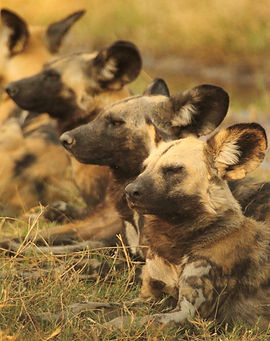Our Research and Conservation Projects
KRC undertakes a holistic research program examining key conservation and management issues relevant to the unique Kalahari environment. To date this has involved the collection of baseline ecological data, a detailed predator guild and herbivore survey and an analysis of predator-prey relationships within the region.
The study is improving our understanding of the regions underlying system dynamics, and examining the regulatory factors and population dynamics of wildlife species living in the study area and the interface between this wildlife and resident human population.

-min.png)

Wild Dogs CKGR
African wild dogs (Lycaon Pictus) are listed as Endangered and the global population is declining (IUCN 2012) as a result of anthropogenic factors causing habitat fragmentation and loss.
Whilst it is known that African wild dogs live in the Kalahari, possibly in high numbers, these Kalahari wild dogs are un-mapped and poorly understood. As much as 40% of Botswana’s total population may be found in the Kalahari region.
This area provides a critical role in connecting regional sub-populations of wild dogs from eastern Namibia across to western Zimbabwe, South Africa and north
toward Zambia. This project aims to put these populations on the map, working with the government and relevant stakeholders to ensure they continue to survive and do not disappear before even being acknowledged.
- Diet, space use and group composition
- Daily time and energy budgets – how do they cope with heat and the aridity as compared to the delta
- How many are there?
- How many in CKGR? Are they a host population


.jpg)
Community Engagement/Education
We conduct a variety of outreach programs in the communities living near the Kalahari Transfrontier Park i.e., KD1 and KD2. Engaging and involving communities is a critical part of wildlife conservation. KD1 (12 000km2) has three small community settlements called Ngwatle (300residents), Ukwi (500) and Ncaang (250). There is one settlement in KD2 (6000 km2), Zutshwa(500 residents). The communities are primarily made up of Bakgalagadi and Basarwa (also known as San Bushmen). Our focal communities at this stage are Zutshwa in KD1 and Ngwatle in KD2. Our community work also involves engagements through workshop training and support for the other stakeholders within the villages including the Village Development Committee, the Trust and the leaders within the communities.
-min.jpg)


Raptors Botswana
Raptors Botswana is a non-profit organisation established by dedicated and passionate conservationists to ensure the survival of raptors in Botswana.
Much of our research focus to date has been on Lappet-faced vultures (these vultures are one of the least well-known vultures and rarest of all African species) but they are now working to conserve all the 5 species of vulture that live in Botswana.
Vultures are particularly sensitive to human disturbance and as populations grow, vultures in Africa are in crisis with numbers plummeting and with many species having recently been upgraded into being either endangered or critically endangered. Our work is making big strides in safeguarding the future of these birds through its Botswana Vulture Research Project.



Lions and Communities
KRC are delighted to announce that we are now in a position to initiate a Lion Conservation
project and twin this with a Conservation Performance Payment Project (CPP) within 2
(Zutshwa and Ngwatle) of the four communities in KD1 and KD2 of SW Botswana.
These two wildlife management areas (WMA’s) are massive landscapes, with a combined size
of 20 000km2. KD1 and KD2 have the highest densities of lions in across all
the WMAs in the region. This is due to the still abundant wild prey for lions to feed from and
present low levels of humans and livestock.
However, livestock numbers and cattle post distributions are changing rapidly.
The locations of these new cattle posts mean that they function as a platform to enable more
poaching in the area and the illegal killing of lions.
